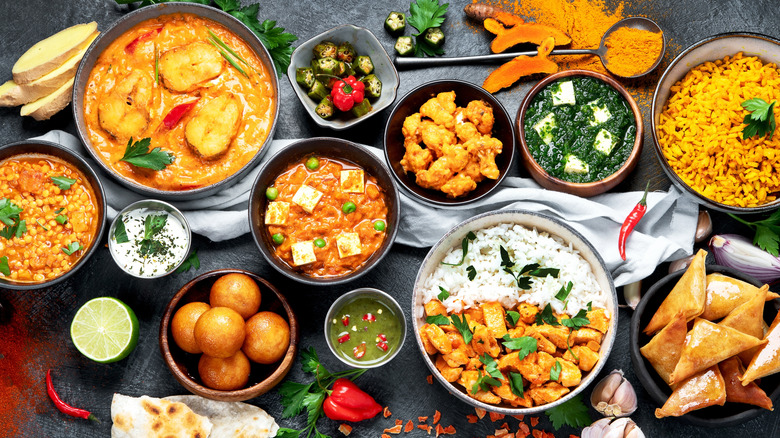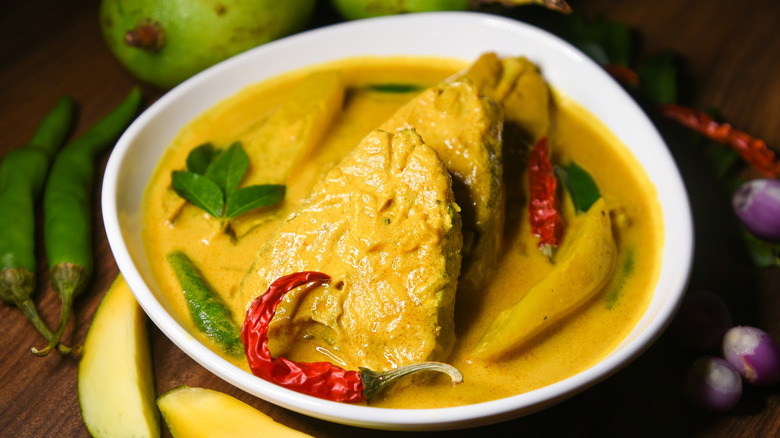Elevate Popular Indian Dishes With A Splash Of Beer
Washing down a fiery plate of Indian food with an ice-cold beer is one way to elevate a meal, but incorporating the brew directly into the food is even better. When it comes to the world of Indian curries, beer is the unexpected ingredient you need. According to chef Gaurav Chawla, executive chef at Farzi restaurant in New York City, whether you're making a curry that's smoky and rich, creamy and bright, or tomato-based and spicy, there's a beer for that.
"Beer brings a very unique balance of malt sweetness, gentle bitterness, and natural carbonation," Chawla told The Takeout. "In a modern Indian curry, these elements help round out sharper spices, lighten richer gravies, and amplify aromatics."
To get the most out of cooking with beer, it should be added after the initial browning or searing steps of the onions, ginger, garlic, and dry spices. " ... Adding beer works like deglazing a pan. It lifts the browned bits, deepens flavor, and integrates with the spices without losing carbonation too early," Chawla explained. You can also incorporate it after searing proteins in meat-based curries or just before adding dairy or coconut milk in creamy dishes. "It creates a curry that tastes deeper, silkier, and more layered without losing its Indian identity," he shared.
The best beers to use in Indian curries
It's important to note that "curry" is an extremely broad term. It was initially a vague word used by British colonizers to describe Indian food and spice blends, lumping a complex and varied cuisine into one unspecific category. As such, the ideal beer to use when making Indian food will vary widely based on the dish you're making.
"I lean toward beer styles that work with the masala, not against it," chef Gaurav Chawla explained. The masala simply refers to the blend of spices used in a dish — it is not a ready-made spice mix but rather a combination unique to each recipe and chef. "Wheat beers and hefeweizens pair beautifully with creamy or coconut-based curries, like our raw mango moilee at Farzi," Chawla said — moilee is a dish that originated in Kerala. He also recommended this brew for dishes with creamy makhani sauces (like butter chicken) or cashew-based Punjabi lababdar sauces.
"Lagers and pilsners are clean and crisp, making them ideal for classic onion-tomato gravies," Chawla explained. "Amber ales or Belgian ales complement slow-cooked, roasted-spice curries because of their deeper malt profile." Even dark beers like stouts and porters can be used in small amounts, especially in dishes that have meats or vegetables that are grilled on a sigri or roasted in a tandoor oven, to reinforce smoky, charred, and deeply roasted flavors.
Don't add these beers to Indian food
"Beer pairing with Indian food is about balancing intensity and echoing flavor notes," chef Gaurav Chawla explained, which means that it is possible to overdo it when it comes to incorporating beer. For example, Chawla recommended an IPA for fiery Rajasthani laal maas or spicy Marathi Kolhapuri dishes (which often feature a red chile called lavangi mirchi). "The IPA hop bitterness stands up to the heat," he said. However, "Anything too extreme can disrupt the spice harmony," he cautioned. "Overly hoppy IPAs tend to become aggressively bitter when heated."
Chawla also warned against using very fruity beers, as they can taste artificial once they've cooked down. "Sour beers can throw off the acidity and make spices taste sharp. High-alcohol beers reduce poorly and can introduce harsh flavors," he added.
Taste the beer on its own first, and consider how the flavor profile will evolve as it cooks down. You can also thoughtfully incorporate interesting ingredients that harmonize with the beer, spices, and aromatics. "Smoked ghee adds depth that pairs beautifully with malt and roasted notes," Chawla shared. "A touch of jaggery can round off bitterness and add gloss to the curry." Really, it's all about balance. "The goal is finesse, not overpowering the masala," he said.


